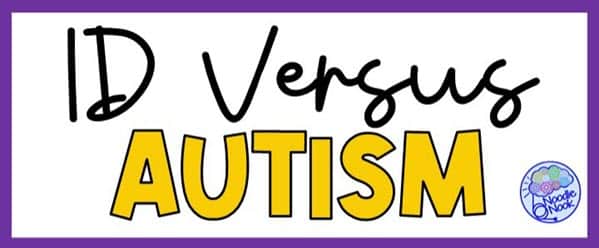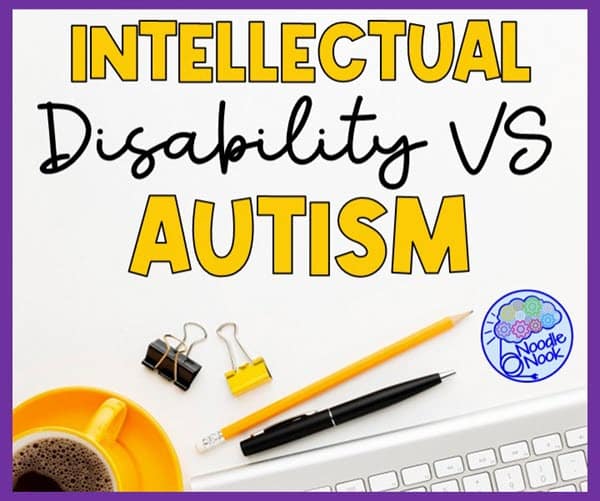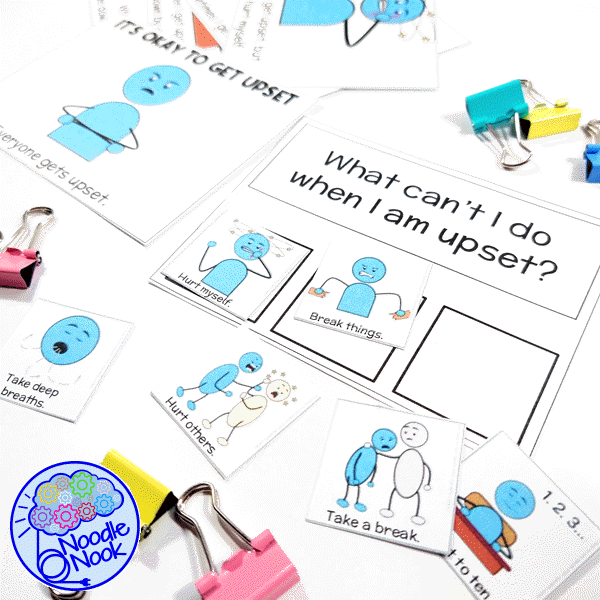As a teacher, adjusting instruction and classroom management to meet the needs of students can be tough. It’s made even harder when students have a wide variety of disabilities in one classroom. In this post, we are going to dish on the main differences between individuals with an intellectual disability vs autism. Hopefully, this will help you set up an inclusive classroom that is responsive to student needs.
How Things Have Changed
Back in the good old days, both an intellectual disability (ID) and autism (AU) were generally just considered forms of “mental retardation”. In terms of neurodevelopmental disorders, autistic children and kids with developmental disabilities were just clumped into one bucket and labeled “special”. We have come a long way since then in terms of the diagnosis of intellectual disability as well as the diagnosis of autism spectrum disorder as two very different things. Now, we consult health professionals and medical professionals to determine if an individual qualifies according to the Diagnostic & Statistical Manual of Mental Disorders (DSM) and according to the American Psychiatric Association. We also look at IQ test and IQ scores to assist in the diagnosis of ASD and ID.
How Common Are These Disabilities
Over the last several years, the occurrence of autism has increased starkly, that statement deserves an asterisk though. As we talk about prevalence, it’s essential to note that incidence rates have changed a lot due to improved diagnostic criteria, awareness, and changes in data collection methods.
With that said, here is a general overview of the incidence rates for ID and AU:
Intellectual Disability (ID):
The prevalence of ID varies from country to country, but on average, it affects approximately 1-3% of the population. In the United States, the Centers for Disease Control and Prevention (CDC) reported an estimated prevalence of 1.2% among children aged 3 to 17 years in 2016. Black and Hispanic children are more likely to be diagnosed with an intellectual disability than their white counterparts.
The historical incidence of ID is challenging to determine accurately due to limited historical data and differences in diagnostic criteria. However, there is evidence that improved healthcare and interventions have led to a decline in the prevalence of severe intellectual disabilities. There was a history in America of forced sterilization of mothers of children with an intellectual disability, especially in minority populations (Stern, 2020). This campaign has long since been stopped, but it may have impacted historical tracking.
Autism Spectrum Disorder (ASD):
Autism spectrum disorder has seen an increase in prevalence over the past few decades. As of 2021, the CDC reported that approximately 1 in 54 children in the United States had been identified with ASD, indicating a prevalence rate of about 1.85%. More recent data from the CDC in 2023 now shows one in 36 eight-year-old children have ASD, which is an increase to 2.8% prevalence rate (CDC, 2023). According to a recent study, white children tend to be diagnosed as having an autistic disorder more than their minority counterparts. But, for children with ASD, black children were found to be more likely to also have an intellectual disability (Maenner, Warren, Williams, & al., 2023).
The historical incidence of autism is somewhat controversial due to changes in diagnostic criteria and increased awareness. In the past, autism was often underdiagnosed or misdiagnosed, leading to lower reported rates. With increased awareness and understanding, the prevalence of autism has risen in recent years. With that said, current testing may still overlook highly intelligent individuals with autism as well as those who have less prominent adverse behaviors.
Key Similarities Between ID and Autism
There are some ways in which individuals with autism and an intellectual disability are similar. That means as a teacher, you can provide some similar supports. Both an ID and AU diagnosis share these things:
1. Onset in Early Development
Both intellectual disabilities and autism typically become evident during early childhood. Signs of these conditions often start to manifest in the first few years of life, and early intervention is crucial for optimizing outcomes and providing necessary support.
2. Impact on Daily Functioning
Both conditions can significantly impact a person’s daily functioning and independence. Individuals with intellectual disabilities and autism may face challenges in areas such as communication skills/language skills, social interaction, self-care, and adaptive behaviors.
3. Support and Interventions
Individuals with intellectual disabilities and autism benefit from various support services and interventions tailored to their specific needs. Early intervention programs, speech therapy, occupational therapy, and behavioral interventions are examples of interventions that can be helpful for both conditions. Though recent studies show these benefits, children in underserved communities are less likely to receive these types of services, especially as young children when the impact is most profound.
4. Spectrum Nature
Both intellectual disabilities and autism are considered spectrum disorders. This means that there is a range of severity levels and manifestations for each condition. Intellectual disabilities can range from mild to severe, and autism presents with a wide variety of symptoms and behaviors across the spectrum.
5. Lifelong Conditions
Both intellectual disabilities and autism are typically lifelong conditions. While early intervention and support can make a significant difference in improving outcomes, individuals with these conditions may continue to experience challenges and require ongoing assistance throughout their lives.
Key Differences Between ID and Autism
Likewise, there are a few key differences between ID and AU that keep them distinct, including:
1. Nature of Impairments
Intellectual Disabilities (ID): The primary characteristic of intellectual disabilities is a significant limitation in intellectual functioning. This can manifest as difficulties in learning, problem-solving, and abstract reasoning. Individuals with ID may also have challenges in adaptive behaviors, affecting their ability to perform everyday tasks.
Autism Spectrum Disorder (ASD): Autism is primarily characterized by difficulties in social communication and behavior. While cognitive abilities can vary, the defining features of autism include challenges in social interaction, understanding and using nonverbal communication, and engaging in reciprocal relationships.
2. Social Communication
Intellectual Disabilities (ID): Individuals with ID may have varying degrees of difficulty with communication, but the challenges are primarily related to their cognitive limitations rather than specific social communication impairments.
Autism Spectrum Disorder (ASD): Social communication difficulties are a core feature of autism. Individuals with autism may struggle with understanding social cues, nonverbal expressions, maintaining eye contact, and using gestures appropriately.
3. Repetitive Behaviors and Restricted Interests:
Intellectual Disabilities (ID): Intellectual disabilities do not include the characteristic repetitive behaviors and restricted interests seen in autism.
Autism Spectrum Disorder (ASD): Repetitive behaviors, such as hand-flapping, rocking, echolalia (repeating words or phrases), and adherence to strict routines, are common features of autism. Individuals with autism may also have intense and specific interests in particular subjects.
4. Sensory Sensitivities:
Intellectual Disabilities (ID): Sensory sensitivities are not a defining feature of intellectual disabilities, although individuals with ID may still experience sensory issues to some extent.
Autism Spectrum Disorder (ASD): Many individuals with autism have sensory sensitivities, which can involve being overly sensitive to certain stimuli (e.g., loud noises, bright lights) or seeking sensory input (e.g., spinning, touching specific textures).
5. Co-occurring Conditions:
Intellectual Disabilities (ID): Intellectual disabilities can coexist with various other conditions, but the presence of these conditions may not necessarily be a defining factor of ID itself.
Autism Spectrum Disorder (ASD): Autism often co-occurs with other conditions, such as intellectual disabilities, language impairments, epilepsy, and attention-deficit/hyperactivity disorder (ADHD).
6. Assessment and Diagnosis:
Intellectual Disabilities (ID): Intellectual disabilities are primarily diagnosed based on standardized intelligence tests and assessments of adaptive functioning.
Autism Spectrum Disorder (ASD): Autism diagnosis involves careful observation of social communication, behavior, and developmental history, often using standardized tools like the Autism Diagnostic Observation Schedule (ADOS) and the Autism Diagnostic Interview-Revised (ADI-R).
Tips for Teachers: How to Support Students in the Classroom
As you prepare your classroom to be inclusive of all students and responsive to their needs, consider these supports. Remember, individualization is the name of the special education game. Really look at the needs of the student to determine which supports you need most. Then implement them with consistency and teach them using explicit instruction.
Supporting All Students
Although there are differences between students with an intellectual disability and autism, some teaching tips generally work for both diagnoses in the classroom.
1. Predictable Schedules
Establishing predictable routines and schedules can benefit students with ID and AU. Consistent daily routines provide a sense of structure and security, helping students feel more comfortable and better able to focus on their learning tasks. Use visual aids or classroom schedules to make the routine visible, allowing students to anticipate transitions and activities.
2. Visual Supports
Both students with ID and AU often benefit from visual supports. Visual aids can enhance understanding and comprehension by providing additional context and reinforcement. Use visual cues, such as charts, pictures, or diagrams, to accompany verbal instructions or lesson content. Visual supports can aid in organizing information, making it more accessible for students with diverse learning styles.
3. Explicit Social Skills Instruction
Teaching social skills explicitly is crucial for students with both ID and AU. While the specific social challenges may differ between the two groups, focusing on communication, turn-taking, listening, and empathy can benefit all students. Consider incorporating social skills training into the curriculum and reinforcing positive social interactions within the classroom. (Check out these social story ideas.)
4. Modeling Communication
For students with ID and AU, communication can be a significant area of difficulty. Teachers can support communication development by modeling clear and effective communication themselves. Use simple language, gestures, and facial expressions to enhance understanding. Encourage all students to express themselves and be patient when waiting for responses.
5. Peer Interactions and Groups
Promote peer interactions and collaborative group activities in the classroom. Both students with ID and AU can benefit from working with their peers, fostering a sense of belonging and encouraging social development. Encourage inclusive group projects and pairings, creating opportunities for students to learn from one another and build friendships.
Tips for Teachers: Supporting Intellectual Disabilities
1. Individualized Instruction
Recognize that students with intellectual disabilities may have diverse learning needs and abilities. Tailor your teaching methods to accommodate individual strengths and challenges. Offer additional support, repetition, or alternative learning materials as needed.
2. Multi-Sensory Teaching
Engage students with intellectual disabilities through multi-sensory teaching techniques. Incorporate auditory, visual, and kinesthetic elements into lessons to reinforce learning and cater to various learning styles.
3. Chunking
For complex tasks or assignments, break them down into smaller, manageable steps. This approach can make tasks less overwhelming and help students with ID understand and complete them more effectively.
Tips for Teachers: Supporting Autism
Sensory-Friendly Environment
Create a sensory-friendly classroom by minimizing unnecessary noise, providing comfortable seating options, and using calming colors. Consider providing sensory tools like fidget toys or noise-canceling headphones for students who may benefit from them.
Clear and Concise Instructions
When giving instructions, be clear, concise, and specific. Avoid using idiomatic language or sarcasm, as students with autism may have difficulty interpreting figurative language.
Sensitivity to Overstimulation
Be mindful of potential triggers that could overwhelm students with autism. If you notice signs of distress or sensory overload, provide a quiet space where they can take a break and self-regulate.
RECAP: Intellectual Disability vs Autism
Understanding the main differences between intellectual disability and autism is crucial for educators striving to create inclusive and supportive environments for all students. While both conditions share some similarities, such as early onset and the need for tailored interventions, their distinct characteristics necessitate targeted approaches in teaching and support. As we continue to learn more about intellectual disability and autism through ongoing research and future studies, we can continue to update practices in the classroom. This responsiveness to student needs can have a huge impact on student outcomes and learning over a lifetime.
Additional FAQ Section: 10 Common Questions
Q1: What are the key differences between developmental delays and intellectual disability (ID)?
A: Developmental delays refer to children who do not reach developmental milestones at the expected age. It’s important to note that not all children with developmental delays will have an intellectual disability. Intellectual disability, on the other hand, is characterized by significant limitations in intellectual functioning and adaptive behaviors. These affect a person’s ability to perform everyday tasks. Developmental delays can be temporary and may resolve with early intervention, while intellectual disabilities are typically lifelong conditions.
Q2: Are autism and intellectual disability (ID) always related to a genetic condition?
A: While both autism and intellectual disability can have genetic components, not all cases are directly linked to specific genetic syndromes. In some cases, the cause of autism or intellectual disability may be due to genetic factors, while in others, it may be caused by environmental influences or a combination of genetic and environmental factors. Genetic conditions like Angelman syndrome and tuberous sclerosis are associated with an increased risk of intellectual disability and may co-occur with autism in some cases.
Q3: Can individuals with autism be highly intelligent and have a high intellect?
A: Yes, individuals with autism can have a wide range of cognitive functioning, and some may have above-average intelligence or high intellect. Autism does not solely determine a person’s intelligence quotient (IQ) or intellectual ability. In fact, there are cases of individuals with autism who demonstrate exceptional abilities in specific areas, known as savant skills. It is essential to recognize and support the diverse cognitive strengths and abilities of autistic people.
Q4: How does attention deficit hyperactivity disorder (ADHD) differ from autism?
A: Attention deficit hyperactivity disorder (ADHD) is a separate neurodevelopmental disorder from autism. ADHD is primarily characterized by symptoms of inattention, hyperactivity, and impulsivity. While some symptoms may overlap, such as difficulties with focus and attention, the core features of autism are challenges in social communication and behavior. A clinical psychologist or qualified healthcare professional can conduct assessments to differentiate between ADHD and autism and provide an accurate diagnosis.
Q5: What are some of the neurological disorders associated with autism?
A: Autism is considered a neurodevelopmental disorder, and although its exact neurological basis is not fully understood, researchers have identified some neurological differences in the brains of individuals with autism. Some neurological conditions that may co-occur with autism include epilepsy, motor skills impairments, and visual processing disorders. These neurological aspects can contribute to the unique characteristics and challenges experienced by autistic individuals.
Q6: How do autism rates differ between affluent areas and underserved areas?
A: Studies have shown that autism rates can vary between different communities and socioeconomic statuses. In some affluent areas with better access to healthcare and resources, autism may be diagnosed more frequently due to increased awareness and availability of diagnostic services. On the other hand, in underserved areas, autism may be underdiagnosed or diagnosed later in life due to limited access to healthcare and specialized assessments. Addressing these disparities is crucial to ensure all individuals with autism receive timely and accurate diagnoses and appropriate support.
Q7: How is autism prevalence changing over time, and what factors contribute to this?
A: Autism prevalence has increased over the years, partly due to improved diagnostic criteria, increased awareness, and changes in data collection methods. The reported prevalence of autism has risen in recent years, and some recent studies have shown a higher percent increase in identified cases. However, it is important to consider that this increase may also reflect improvements in accurately identifying individuals with autism who were previously underdiagnosed or misdiagnosed. Future studies and ongoing research are essential to understand the factors contributing to these changes in prevalence.
Q8: Can you have a learning disability along with an intellectual disability or autism?
A: Yes, it is possible for individuals to have co-occurring conditions such as learning disabilities alongside intellectual disability or autism. A learning disability refers to difficulties in acquiring and using specific academic skills despite average or above-average intelligence. These conditions can overlap. It is essential for educators and healthcare professionals to conduct thorough assessments to identify and address the unique needs of individuals with multiple co-occurring conditions.
Q9: What role does early intervention play in supporting individuals with intellectual disability and autism?
A: Early intervention is crucial for both intellectual disability and autism as it can significantly impact outcomes and improve quality of life. For children with developmental delays or concerns about intellectual functioning or autism, early intervention services can provide targeted support to address developmental needs. These services may include speech therapy, occupational therapy, physical therapy, and specialized educational programs provided through special education services. Early intervention aims to enhance developmental progress and support children in reaching their full potential.
Q10: How does the stigma of other mental conditions impact the perception of intellectual disability and autism?
A: The stigma of other mental conditions can affect how intellectual disability and autism are perceived in society. Misunderstandings and negative stereotypes about mental health can lead to misconceptions and discrimination against individuals with these conditions. Raising awareness, promoting inclusivity, and fostering a supportive and understanding environment are essential steps in combating stigma and creating a more accepting society for individuals with intellectual disability and autism.
References
CDC. (2023, 03 23). Autism Prevalence Higher, According to Data from 11 ADDM Communities. Retrieved from Center for Disease Control and Prevention: https://www.cdc.gov/media/releases/2023/p0323-autism.html
Maenner, M., Warren, Z., Williams, A., & al., e. (2023). Prevalence and Characteristics of Autism Spectrum Disorder Among Children Aged 8 Years. doi: http://dx.doi.org/10.15585/mmwr.ss7202a1
Stern, A. M. (2020, 09 23). Forced sterilization policies in the US targeted minorities and those with disabilities – and lasted into the 21st century. Retrieved from Institute for Healthcare Policy and Innovation: https://ihpi.umich.edu/news/forced-sterilization-policies-us-targeted-minorities-and-those-disabilities-and-lasted-21st










